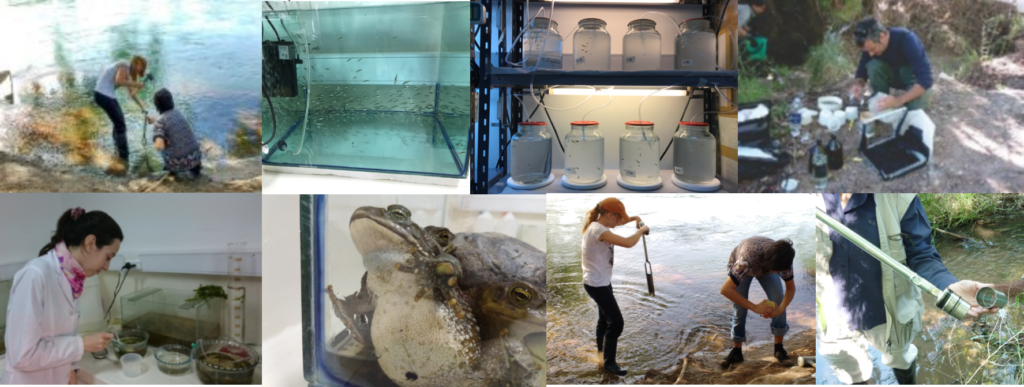- Bioinformática
- Bioindicadores y fitoremediadores de contaminación ambiental.
- Biotecnología de la reproducción animal
- Dinámica de contaminantes ambientales
- Efectos de plaguicidas e hidrocarburos sobre la salud humana
- Efectos de plaguicidas y otros contaminantes en organismos acuáticos
- Estrés abiótico en frutales
- Geociencias
- Identificación, epidemiología y control de microorganismos patógenos de cultivos de importancia regional
- Mecanismos de resistencia en plagas que afectan la producción regional
- Procesos tecnológicos para el tratamiento de residuos líquidos y sólidos

Los trabajos abarcan estudios de blancos moleculares en los mecanismos de acción de tóxicos y su uso como posibles biomarcadores en especies acuáticas, tanto en laboratorio como en su validación a campo. Se aplican técnicas enzimológicas y de biología molecular en el análisis de blancos primarios y secundarios (esterasas), sistemas de defensa antioxidante, factores de transcripción, vías de señalización, mecanismos de biotransformación y detoxificación. Los contaminantes acuáticos en estudio son principalmente plaguicidas, fungicidas, hidrocarburos, nanopartículas, y cianotoxinas. Recientemente se ha incorporado una línea de transcriptomica y bioinformática. El principal modelo experimental es el desarrollo embrionario a partir del anfibio Rhinella arenarum, abarcando también otras especies como: peces (trucha arcoíris Oncorhynchus mykiss y madrecita Jenynsia multidentata), anfípodos (Hyalella curvispina) y bivalvos (Diplodon chilensis).
Además se analizan in vitro, en cultivos celulares, los efectos de la exposición a plaguicidas organofosforados sobre blancos moleculares secundarios como las enzimas de respuesta al estrés oxidativo, y el posible rol de la composición lipídica de la membrana en la acción tóxica de estos compuestos liposolubles. Para ello contamos con líneas celulares genéticamente modificadas con diferentes composiciones lipídicas y propiedades de membrana, modelando así diferentes enfoques nutricionales con respecto a la calidad de los lípidos dietarios.
Grupo de trabajo:
Director: Dr. Andrés Venturino a.venturino@conicet.gov.ar
Codirectora: Dra. Cecilia Lascano - Investigadora Asistente CONICET lascano.cecilia@gmail.com
- Dra. Flavia Bieczynski - Investigador Asistente CONICET flabieczynski@gmail.com
- Dra. María Soledad Jaureguiberry - Investigadora Asistente CONICET solejaure74@gmail.com
- Dr. Enrique Rosenbaum - Investigador UNCO earosenba@yahoo.com.ar
- Dra. Cecilia Lascano - Investigadora Asistente CONICET lascano.cecilia@gmail.com
- Dra. Natalia Susana Pires - Becaria Postdoctoral CONICET natupires1985@gmail.com
- Ing. Amb. Nuria Guadalupe Espert - Becaria Doctoral CONICET, PUE-CITAAC nuuespert@gmail.com
- Ing. Agr. María Carolina Parra - Becaria Doctoral ANPCyT mariacarolinaparra707@gmail.com
- Lic. Biol. Jorgelina Villanova - Becaria Doctoral CONICET jorgelinalv@gmail.com
- Dra. Malena Morell - Profesional Asistente CONICET morellmalena@gmail.com
- Lic. Biotecnol. Julia Ousset - Profesional Asistente UNCo juousset@gmail.com
Producción científica y técnica de los últimos años
2021
- Spermatozoa Obtained From Alpaca vas deferens. Effects of Seminal Plasma Added at Post-thawing. DOI: 10.3389/fvets.2021.611301
2020
- Evaluation of viral concentration methods for SARS-CoV-2 recovery from wastewaters. DOI: 10.1016/j.scitotenv.2020.144105
- Chemical effects on dye efflux activity in live zebrafish embryos and on zebrafish Abcb4 ATPase activity. DOI: 10.1002/1873-3468.14015
- Differential effects of azinphos-methyl and chlorpyrifos on polyamine oxidative metabolism during the embryonic development of Rhinella arenarum and its relation to oxidative stress. DOI: 10.1016/j.pestbp.2019.10.007
- Evaluation of viral concentration methods for SARS-CoV-2 recovery from wastewaters. DOI: 10.1016/j.scitotenv.2020.144105
- Nutritional and environmental contributions to Autism Spectrum Disorders: Focus on nutrigenomics as complementary therapy. DOI: 10.1024/0300-9831/a000630
- Sensitivity of Boana pulchella (Anura: Hylidae) tadpoles to environmentally relevant concentrations of chlorpyrifos: effects at individual and biochemical level. DOI: 10.1002/etc.4664
- The Rhinella arenarum transcriptome: de novo assembly, annotation and gene prediction. DOI: 10.1038/s41598-020-57961-4
2019
- Differential detoxifying responses to crude oil water-accommodated fraction in Hyallela curvispina individuals from unpolluted and contaminated sites. DOI: 10.1016/j.etap.2019.04.012
- Ex vivo and in vivo effects of arsenite on GST and ABCC2 activity and expression in the middle intestine of the rainbow trout Oncorhynchus mykiss. DOI: 10.1016/j.cbpc.2019.108566
- Joint probabilistic analysis of risk for aquatic species and exceedence frequency for the agricultural use of chlorpyrifos in the Pampean region, Argentina. DOI: 10.1002/etc.4441
2018
- Chemical characterization and toxicity of water-accommodated fraction of oil on the South American native species Hyalella curvispina. DOI: 10.1016/j.etap.2018.04.022
- Effects of sequential exposure to water accommodated fraction of crude oil and chlorpyrifos on molecular and biochemical biomarkers in rainbow trout. DOI: 10.1016/j.cbpc.2018.07.003
- Immune and biochemical responses in hemolymph and gills of the Patagonian freshwater mussel Diplodon chilensis, against two microbiological challenges: Escherichia coli and Saccharomyces cerevisiae. DOI: 10.1016/j.jip.2018.08.005
2017
- Acute toxicity and esterase response to carbaryl exposure in two different populations of amphipods Hyalella curvispina. DOI:10.1016/j.aquatox.2017.04.013
- Arsenic absorption and excretion in chronically exposed developing toad Rhinella arenarum. DOI: 10.1016/j.etap.2017.04.014
- Chronic toxicity of arsenic during Rhinella arenarum toad embryonic and larval development: biomarkers of oxidative stress and antioxidant response. DOI: 10.1002/etc.3693
- Modulation of immune and antioxidant responses by azinphos-methyl in the freshwater mussel Diplodon chilensis challenged with Escherichia coli. DOI: 10.1002/etc.3612
- Molecular effectors in the chronic exposure to arsenic as early and sensitive biomarkers in developing Rhinella arenarum toads. DOI: 10.1016/j.aquatox.2017.02.019
- Toxicogenomics: New strategies for ecotoxicology studies in autochthonous species. I. A glade in the entangled path towards the ´fingerprint´ of environmental impact?. DOI: 10.1504/IJENVH.2017.086179
- Toxicogenomics: new strategies for ecotoxicology studies in autochthonous species II. The 'omic' era in non-model species. Transcriptome analysis for biomarker screening. DOI: 10.1504/IJENVH.2017.086180
2016
- Alterations in the intestine of Patagonian silverside (Odontesthes hatcheri) exposed to microcystin-LR: Changes in the glycosylation pattern of the intestinal wall and inhibition of multidrug resistance proteins efflux activity. DOI: 10.1016/j.aquatox.2016.07.016
- Comparative study of toxicity and biochemical responses induced by sublethal levels of the pesticide azinphosmethyl in two fish species from North-Patagonia, Argentina. DOI: 10.1016/j.aquatox.2016.06.015